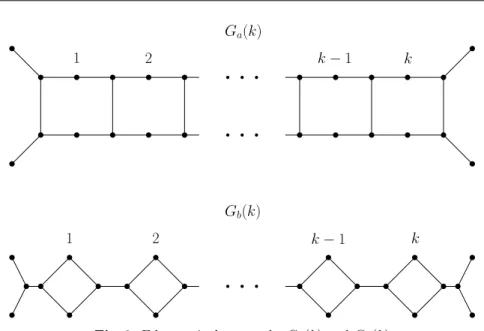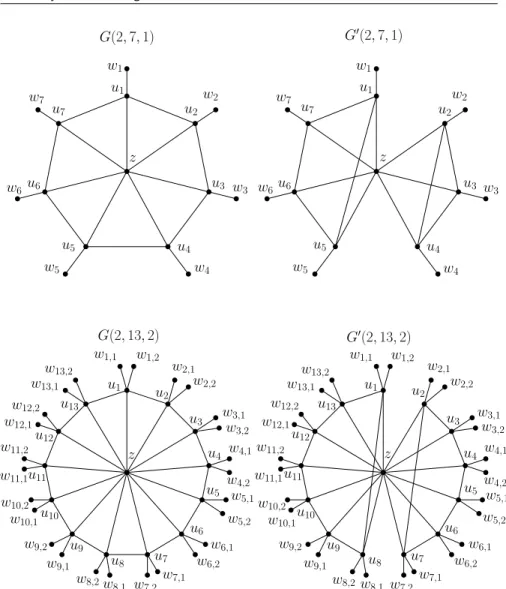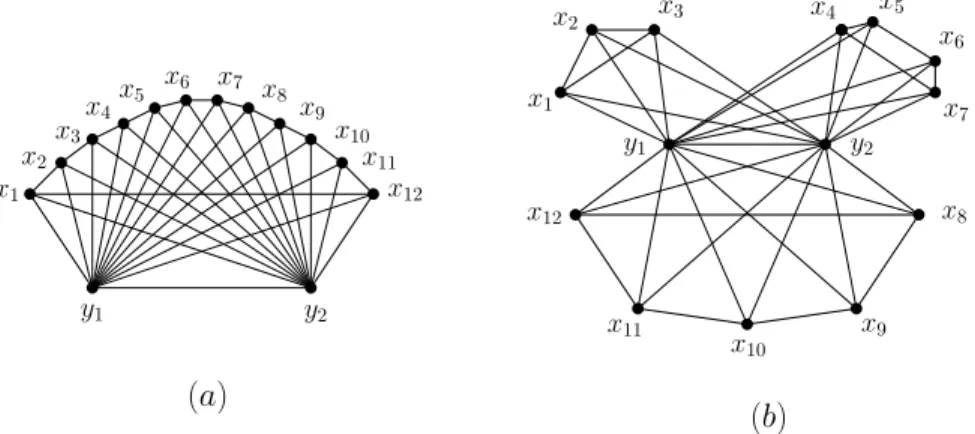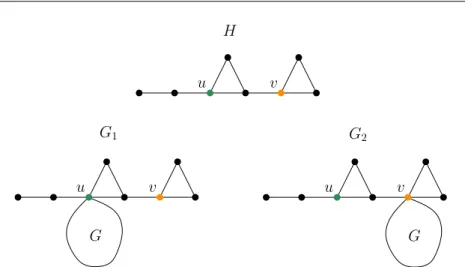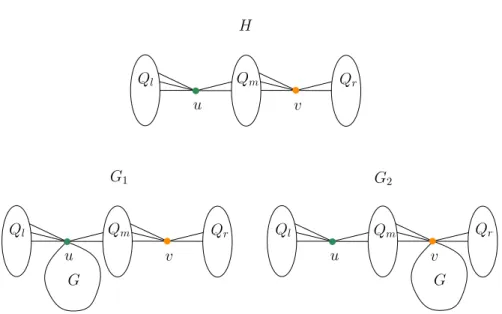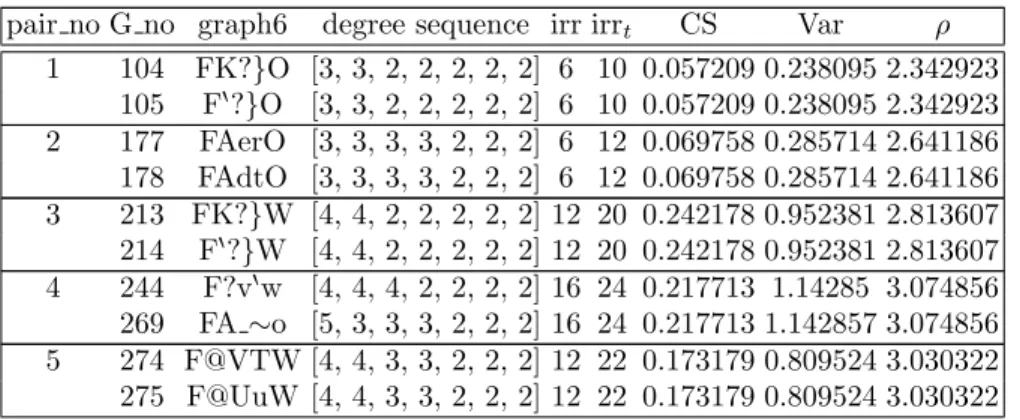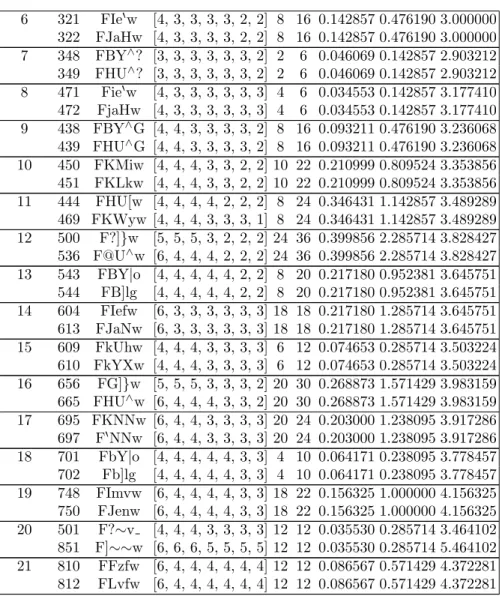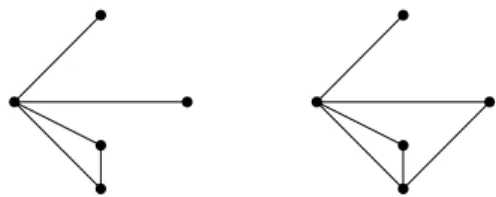Graphs with Equal Irregularity Indices
Darko Dimitrov
1, Tam´ as R´ eti
21Institute of Computer Science, Freie Universit¨at Berlin Takustraße 9, D–14195 Berlin, Germany
E-mail:dimdar@zedat.fu-berlin.de
2Obuda University´
B´ecsi ´ut 96/B, H-1034 Budapest, Hungary E-mail:reti.tamas@bgk.uni-obuda.hu
Abstract: The irregularity of a graph can be defined by different so-called graph topological indices. In this paper, we consider the irregularities of graphs with re- spect to the Collatz-Sinogowitz index [8], the variance of the vertex degrees [6], theirregularity of a graph[4], and thetotal irregularity of a graph[1]. It is known that these irregularity measures are not always compatible. Here, we investigate the problem of determining pairs or classes of graphs for which two or more of the above mentioned irregularity measures are equal. While in [17] this problem was tackled in the case of bidegreed graphs, here we go a step further by considering tridegreed graphs and graphs with arbitrarily large degree sets. In addition we pressent the smallest graphs for which all above irregularity indices are equal.
Keywords:irregularity measures of graph; topological graph indices
1 Introduction
Let G be a simple undirected graph of order n = |V(G)| and size m =
|E(G)|. The degree of a vertexv in Gis the number of edges incident with v and it is denoted by dG(v). A graph G is regular if all its vertices have the same degree, otherwise it isirregular. However, in many applications and problems it is of big importance to know how irregular a given graph is.
The quantitative topological characterization of irregularity of graphs has a growing importance for analyzing the structure of deterministic and random networks and systems occurring in chemistry, biology and social networks [7, 12]. In this paper, we consider four graph topological indices that quantify the irregularity of a graph. Before we introduce those indices, we present some necessarily notions and definitions.
A universal vertex is the vertex adjacent to all other vertices. We denote by mr,s the number of edges inG with end-vertex degrees r ands, and by nr the numbers of vertices n G with degree r. Numbers mr,s and nr are referred as theedge-parametersand thevertex-parametersofG, respectively.
Themean degreeof a graphGis defined asd(G) = 2m/n. GraphsG1andG2
are said to beedge-equivalentif for their corresponding edge-parameters sets {mr,s(G1)>0}={mr,s(G2)>0}holds. Analogously, they are calledvertex- equivalent if for their vertex-parameters sets {nr(G1)>0}={nr(G2)>0} is fulfilled.
A sequence of non-negative integers D= (d1, d2, . . . , dn) is said to begraph- ical if there is a graph with n vertices such that vertex i has degree di. If in additiond1 ≥d2≥ · · · ≥ dn thenD is a degree sequence. The degree set, denoted by D(G), of a simple graph G is the set consisting of the distinct degrees of vertices inG.
The adjacency matrix A(G) of a simple undirected graph G is a matrix with rows and columns labeled by graph vertices, with a 1 or 0 in position (vi, vj) according to whethervi andvj are adjacent or not. Thecharacteris- tic polynomial φ(G, t) of G is defined as characteristic polynomial of A(G):
φ(G, λ) = det(λIn−A(G)), where In is n×n identity matrix. The set of eigenvalues of the adjacent matrix A(G) is called thegraph spectrum of G.
The largest eigenvalue ofA(G), denoted byρ(G), is called thespectral radius of G. Graphs that have the same graph spectrum are called cospectral or isospectralgraphs.
The four irregularity measures of interest in this study are presented next.
The first one is based on the spectral radius of graph. If a graphGis regular, then it holds that the mean degreed(G) is equal to its spectral radiusρ(G).
Collatz and Sinogowitz [8] introduced the difference of these quantities as a measure of irregularity of G:
CS(G) =ρ(G)−d(G).
The first investigated irregularity measure that depends solely on the vertex degrees of a graphGis thevariance of the vertex degrees, defined as
Var(G) = 1 n
n
X
i=1
d2G(vi)− 1 n2
n
X
i=1
dG(vi)
!2 .
Bell [6] has compared CS(G) and Var(G) and showed that they are not always compatible. Albertson [4] defines theirregularityofGas
irr(G) = X
uv∈E
|dG(u)−dG(v)|.
In [1] a new irregularity measure, related to the irregularity measure by Al- bertson was introduced. This measure also captures the irregularity only by the difference of vertex degrees. For a graphG, it is defined as
irrt(G) = 1 2
X
u,v∈V(G)
|dG(u)−dG(v)|.
Very recently, irr and irrtwere compared in [9].
These irregularity measures as well as other attempts to measure the irregu- larity of a graph were studied in several works [2, 3, 5, 13–15]. It is interesting that the above four irregularity measures are not always compatible for some pairs of graphs. The main purpose of this paper is to determine classes of graphs for which two or more of the above mentioned irregularity measures are equal.
The rest of the paper is organized as follows: In Section 2 we investigate tridegreed graphs that have equal two or more of the above presented regu- larity measures. In Section 3 we consider the same problem but for graphs with arbitrary large degree sets. The smallest graphs with equal irregularity measures are investigated in Section 4. Final remarks and open problems are presented in Section 5.
2 Tridegreed graphs
Most of the results presented in this section are generalized in Section 3.
However, due to the uniqueness of the related proofs and used constructions, we present the results of tridegreed graphs separately.
2.1 An infinite sequence of tridegreed graphs with same irr and irrt indices
Proposition 1. Let n be an arbitrary positive integer larger than 7. Then there exists a tridegreed graph with n vertices J(n) for which irr(J(n)) = irrt(J(n))holds.
Proof. The graph J(n) can be constructed as J(n) = Cn−3+P3, where Cn−3 is a cycle on n−3 vertices and P3 is a path on 3 vertices. It is easy to see that the graph obtained is tridegreed if n is larger than 7, and it contains one universal vertex, exactly. The vertex degree distribution ofJ(n) is n5 =n−3,nn−2 = 2 and nn−1 = 1. It can be shown that for J(n) the equality irr(G) = irrt(G) holds. As an example graph J(9) is depicted in Figure 1.
It is easy to show that for graphJ(9) the corresponding edge parameters are:
m5,5= 6, m5,7 = 12, m5,8 = 6, m7,8 = 2. Moreover, the equality irr(J(9)) =
irrt(J(9)) = 44 holds.
2.2 Pairs of tridegreed graphs with same irr,irrt and Var indices Theorem 1. Let Ga andGb be connected edge-equivalent graphs. Then the equalitiesirr(Ga) = irr(Gb),irrt(Ga) = irrt(Gb)andVar(Ga) = Var(Gb)hold.
Fig. 1.The tridegreed graphJ(9)
Proof. By definition, irr(G) depends solely on the edge parameters of G.
Since graphsGaandGbhave same edge parameters, it follows that irr(Ga) = irr(Gb). From the definitions of irrt(G) and Var(G) indices, we have
irrt(G) = 1 2
X
u,v∈V(G)
|d(u)−d(v)|=X
r
X
s<r
nrns(r−s),
Var(G) = 1 n
X
u∈V(G)
d2(u)− 2m
n 2
= 1 n
X
r
nr
r−2m
n 2
.
So, irrt(G) and Var(G) depend only on the vertex parameters ofG. Since r·nr(G) =X
s6=r
mr,s+ 2mr,r,
it follows that if graphs Ga and Gb are edge-equivalent, then Ga and Gb
are necessarily vertex-equivalent as well, that is they have identical vertex- parameter set. Then, it also holds that irrt(Ga) = irrt(Gb) and Var(Ga) =
Var(Gb).
In Figure 2, two infinite sequences of pairs of tridegreed planar graphs that satisfied Theorem 1 are depicted. For a fixed integerk≥1, the graphGa(k) containskhexagons, while the graphGb(k) containskquadrangles. Graphs Ga(k) and Gb(k) have identical edge-parameters: m3,1 = 4, m3,2 = 4k, m3,3 = k+ 1, and n = 4k+ 6, m = 5k+ 5. This implies that Ga(k) and Gb(k) have identical irregularity indices irr, irrt and Var.
In what follows, we will verify that the converse of Theorem 1 is not true.
Proposition 2. There exist tridegreed connected graphs with different edge- parameter distributions but identicalirr,irrt,VarandCSirregularity indices.
Proof. An example is given in Figure 3. It is easy to see that polyhedral graphs (nanohedra graphs) depicted in Figure 3 are characterized by the following fundamental properties:
i) Polyhedral graphsGc andGd have n= 8 vertices andm= 15 edges.
1 2 k−1 k Ga(k)
Gb(k) 2
1 k−1 k
Fig. 2.Edge-equivalent graphsGa(k) andGa(k)
Gc Gd
Fig. 3. Tridegreed polyhedral cospectral graphs [16] having identical degree se- quence and different edge-parameter distribution, but identical irr,irrt,Var and CS irregularity indices
ii) They have the same degree distribution:n3= 4,n4= 2 andn5= 2. This implies that Var(Gc) = Var(Gd), and their total irregularity indices are equal, irrt(Gc) = irrt(Gd).
iii) Their edge-parameter distributions are different, namely for graphGc(m33= 1, m34= 4, m35= 6, m45= 4) and for graphGd(m34= 6, m35= 6, m45= 2, m55= 1).
iv) Their Albertson indices are equal, irr(Gc) = irr(Gd) = 20. (This is an interesting fact, because the edge-parameter distributions of graphs Gc
andGd are different).
v) Gc and Gd are isospectral graphs (polyhedral twin graphs) [16] . This implies that their Collatz-Sinogowitz indices are equal, as well.
2.3 Pairs of tridegreed graphs with same irr,irrt,Var and CS indices
First, we state some necessary definitions and results needed for the derivation of the main results of this section. A bipartite graphGissemiregularif every edge ofGjoins a vertex of degreeδto a vertex of degree∆. The 2-degree of a vertex u, denoted by d2(u) is the sum of degrees of the vertices adjacent tou[20]. The average-degree ofuisd2(u)/d(u) and it is denoted byp(u). A graphGis calledpseudo-regular(orharmonic) if every vertex ofGhas equal average-degree. A bipartite graph is calledpseudo-semiregularif each vertex in the same part of a bipartition has the same average-degree [20]. It follows that semiregular graphs form a subset of pseudo-semiregular graphs.
Theorem 2 ( [20]).LetGbe a connected graph with degree sequence(d1, d2, . . . , dn).Then
ρ(G)≥
sd2(v1)2+d2(v2)2+· · ·+d2(vn)2 d21+d22+· · ·+d2n ,
with equality if and only ifGis a pseudo-regular graph or a pseudo-semiregular graph.
The following result is a consequence of Theorem 2.
Corollary 1 ( [20]). Let Gbe a pseudo-regular graph withd2(v) =p·d(v) for each v∈V(G), thenρ(G) =p.
Theorem 3. There are infinitely many pairs of tridegreed pseudo-regular graphs (G1, G2) for whichirr(G1) = irr(G2),irrt(G1) = irrt(G2),Var(G1) = Var(G2), andCS(G1) = CS(G2).
Proof. We prove the theorem by a construction. Let G(2, x, y) be a graph with vertex setV(G(2, x, y)) =U∪W∪ {z}with connectivity determined as follows: vertex setU ={u1, u2, . . . , ux}induces connected 2-regular subgraph (cyclec1c2·cx);W is comprised ofy·xpendant vertices such that each vertex fromU is adjacent toyvertices fromW; and the ‘central vertex’zis adjacent to each vertex from U. Two instances of such graphs, G1 =G(2,7,1) and G3 =G(2,13,2), are depicted in Figure 4. The parameter 2 in the graph’s representation indicates that the vertex set U induces connected 2-regular subgraph. The average degree of a vertex fromU is (2(3 +y) +x+y)/(3 +y).
The average degree of a vertex fromWis 3+y, which is also the average degree ofz. Thus,G(2, x, y) is pseudo-regular graph if (2(3 +y) +x+y)/(3 +y) = (3 +y), or if
x=y2+ 3y+ 3. (1)
G(2,13,2)
G(2,7,1) G0(2,7,1)
G0(2,13,2)
z z
u1 u2 u1 u2
u3 u3
u4
u4
u5 u5
u6 u6
u7
u7
u8 u8
u9
u9
u10 u10
u11 u11
u12
u12
u13 u13
w1,1 w1,2 w1,1 w1,2
w2,1
w2,2 w2,2
w2,1
w3,1
w3,2
w4,1
w4,2
w3,1
w3,2
w4,1
w4,2
w5,1
w5,2
w5,2
w5,1
w6,1
w6,2 w6,2
w6,1
w7,2
w7,1
w7,1
w7,2
w8,2w8,1 w8,2w8,1
w9,1
w9,2
w9,2
w9,1
w10,1
w10,2 w10,2
w10,1
w11,1
w11,2 w11,2
w11,1
w12,1
w12,2 w12,2
w12,1
w13,1
w13,2 w13,2
w13,1
z z
u1 u1
u2
u2
u3 u3
u4
u4
u5 u5
u6
u6
u7 u7
w1 w1
w2
w2
w3 w3
w4
w4
w5 w5
w6
w6
w7 w7
Fig. 4. Pseudo-regular graphs G(2,7,1), G0(2,7,1), G(2,13,2), G0(2,13,2), with ρ(G(2,7,1)) =ρ(G0(2,7,1)) = 4 andρ(G(2,13,2)) =ρ(G0(2,13,2)) = 5
Next, consider a pair of edges (uiui+1, ujuj+1) such that (imodx) + 2< j.
We delete edgesuiui+1andujuj+1 and add edgesuiuj+1 andui+1uj toG1, obtaining a graphG0(2, x, y), which is edge equivalent (and therefore vertex equivalent) toG(2, x, y). Also, the average degrees of the vertices ofG0(2, x, y) are equal to the average degrees of the vertices ofG(2, x, y). By Corollary 1, ρ(G(2, x, y)) = ρ(G0(2, x, y)) = 3 +y, for infinitely many integer solutions (x, y) of (1). This together with the fact that G(2, x, y) and G0(2, x, y) are
edge equivalent, gives thatG(2, x, y) andG0(2, x, y) have equal irr, irrt, Var
and CS indices.
Two pairs of pseudo-regular graphsG(2,7,1) andG0(2,7,1), and pairG(2,13,2) andG0(2,13,2), for which Theorem 3 holds, are depicted in Figure 4. These graphs corresponds to the first two smallest pairs of integers that solve the equation (1).
Observe that the class of pair of graphs that satisfies Theorem 3 can be extended by considering graphsG(k, x, y),k≥2. These graphs are general- ization of G(2, x, y) graphs, in such a way that the vertex set U induces a k-regular subgraph.
An alternative construction. Next, we will present a new construction, that asserts the claim of Theorem 3. This construction is based on so-called Seidel switching[19], which for a vertexvflips all the adjacency relationships with other vertices, i.e, all of the edges adjacent to v are removed and the edges that were not adjacent to v are added. In general, for a subset S of V(G), the graph H is obtain from the graph Gby switching about S if V(H) = V(G) and E(H) = {uv ∈ E(G)|u, v ∈ S or u, v /∈ S} ∪ {uv /∈ E(G)|u∈S and v /∈S}.
Construction by local switching.[ [11]] LetGbe a graph and letπ= (C1, C2, . . . , Ck, D) be a partition of V(G). Suppose that, whenever 1≤i, j≤k and v∈D, we have
(a) any two vertices ofCi have same number of neighbors inCj, and (b) vhas either 0,ni/2 orni neighbors inCi, whereni=|Ci|.
The graphG(π)formed by local switching inGwith respect toπis obtained from G as follows. For each v ∈ D and 1 ≤ i ≤ k such that v has ni/2 neighbors inCi, delete theseni/2 and joinvinstead to the otherni/2 vertices in Ci.
The property of the above construction that will be used here is the following one.
Theorem 4 ( [11]).LetGbe a graph and letπbe a partition ofV(G)which satisfies properties (a) and(b) above. Then G(π) and Gare cospectral, with cospectral compilements.
The following construction is a special case of the construction by local switching, and will be used to construct infinite series of pairs of graph with the property stated in Theorem 3.
An example of the construction by local switching. A graph Gis comprised ofk-regular graphH on even number of vertices and one additional vertexv
adjacent to exactly half of the vertices ofH. Forπ(V(H),{v}), we have that G(π)is obtained by joiningv instead to the other vertices ofH.
In the above example, as it was mentioned in [11], ifH has 2mvertices and a trivial automorphism group, than all 2mm
possible realisations of H are non-isomorphic. By Theorem 4 the graphsGandG(π)are cospectral.Gand G(π)have also same degree setD(G) =D(G(π)) ={k, k+ 1, m}. The number of edges with endvertices with degreesmandk inGis the same as inG(π). The same holds for edges with endvertices with degreesmandk+ 1, andm and m+ 1. Thus, Gand G(π) are edge equivalent, and irr(G) = irr(G(π)), irrt(G) = irrt(G(π)),Var(G) = Var(G(π)) and CS(G) = CS(G(π)). Note that ifH has less than 8 vertices, thenGandG(π)are isomorphic. In Figure 5 an example of Seidel switching forH =C8 (cycle with 8 vertices) is depicted.
Fig. 5.Seidel switching whenH is a cycle with 8 vertices
3 Graphs with arbitrary large degree set and same irregularity indices
3.1 An infinite sequence of graphs with same irr and irrt indices A graphGis acompletek-partitegraph if there is a partitonV1∪ · · · ∪Vk = V(G) of the vertex set, such that uv ∈ E(G) if and only if u and v are in different parts of the partition.
Proposition 3. There is an infinite sequences of graphs G, such that for a graph G∈ G irr(G) = irrt(G)holds.
Proof. If every two vertices of G with different degrees are adjacent, then irr(G) = irrt(G). Graphs that satisfy this condition are the completek-partite
graphs.
3.2 Pairs of graphs with arbitrary large degree set and same irr,irrt, and Var indices
Proposition 4. There are infinitely many graphsG1andG2 with same ar- bitrary cardinality of their degree sets satisfyingirr(G1) = irr(G2),irrt(G1) = irrt(G2), andVar(G1) = Var(G2).
Proof. Consider the graphs G1csl(14,2,4) and G2csl(14,2,4) depicted in Fig- ure 6. The graphs are bidegreed edge-equivalent, belong to the so-calledcom- plete split-like graphs, and were introduced and studied in [17]. Choose ver-
(a) (b)
y1 y2
x1
x2 x3 x4 x5
x6 x7
x8
x9
x10
x11
x12
y1 y2
x1
x2x3
x4x5 x6 x7 x8
x9
x10
x11
x12
Fig. 6.Bidegreed edge-equivalent complete split-like graphs, (a)G1csl(14,2,4) and (b)G2csl(14,2,4)
tices u∈ V(G1csl(14,2,4)) andu ∈V(G2csl(14,2,4)) such that d(u) =d(v).
Attach touan arbitrary graphH obtaining a graph G1. Attach tova copy ofH obtaining a graphG2. The graphsG1 and G2 are also edge-equivalent and therefore, irr(G1) = irr(G2), irrt(G1) = irrt(G2), Var(G1) = Var(G2).
Observe that in the construction, presented in the above proof, one instead of G1csl(14,2,4) and G2csl(14,2,4) can use any edge-equivalent graphs, for example graphsGa(k) andGb(k) in Figure 2.
3.3 Pairs of graphs with arbitrary large degree set and same irr,irrt,Var and CS indices
The 0-sumof two graphsGand H is got by identifying a vertex inG with a vertex inH. To obtain the result of this section, we will use the following theorem and a corollary of it.
Theorem 5 ( [10]). Let F be a 0-sum obtained by merging v in G with v inH, then the characteristic polynomial of F is
φ(F, λ) =φ(G, λ)φ(H\v, λ) +φ(G\v, λ)φ(H, λ)−λφ(G\v, λ)φ(H\v, λ).
Corollary 2 ( [10]).If we holdGand its vertexv fixed, then the character- istic polynomial of the0-sum ofGandH is determined by the characteristic polynomials ofH andH\v.
u v H
u v
G1 G2
G G
u v
Fig. 7.Two cospectral and edge-equvivalent graphsG1andG2 obtained as 0-sums ofH and arbitrary graphG
Theorem 6. There are infinitely many graphs G1 andG2 with same arbi- trary cardinality of their degree sets satisfying irr(G1) = irr(G2),irrt(G1) = irrt(G2),Var(G1) = Var(G2), andCS(G1) = CS(G2).
Proof. LetGbe an arbitrary graph. Consider the graphH in Figure 7. Let G1be a 0-sum ofH andG, obtained by mergingvinGwithvinH, andG2
be a 0-sum obtained by merging uin G with uin H. Note thatH \v and H\uare isomorphic, soφ(H\v, λ) =φ(H\u, λ). Together with Corollary 2, we have that φ(G1, λ) = φ(G1, λ), or that G1 andG2 are cospectral. Also, it is easy to see that G1 and G2 are edge-equivalent. Thus, G1and G2 have
same irr, irrt, Var and CS indices.
A generalization of the example from Figure 7 is given in Figure 8. The graph H is comprised of three isomorphic subgraphs Ql, Qm, Qr, each of order at least 3, and two vertices u and v. Between the vertex v and the subgraph Qr, there are same number of edges as between the vertexu and the subgraphQm. Also, between the vertexuand the subgraphQl, there are same number of edges as between the vertex v and the subgraph Qm. The number of the edges betweenvand subgraphQmdiffers than the number of the edges betweenv and subgraphQr. We require these conditions to avoid an isomorphism of graphsG1andG2, obtained as 0-sums ofH and arbitrary graph G. The graphs G1 and G2 are constructed in the same manner as above: G1 is a 0-sum obtained by merging v in G withv in H, and G2 be a 0-sum obtained by merginguin Gwithuin H. From the construction it follows thatG1 andG2are edge-equivalent. In this case alsoH\vandH\u are isomorphic, soφ(H\v, λ) =φ(H\u, λ). Together with Corollary 2, we have that φ(G1, λ) = φ(G1, λ), or that G1 and G2 are cospectral. Thus, it
G
u v
Qm Qr
G2
Ql
u v
Qm Qr
H
Ql
G
u v
Qm Qr
G1
Ql
Fig. 8.A generalization of the example from Figure 7
holds that irr(G1) = irr(G2), irrt(G1) = irrt(G2), Var(G1) = Var(G2), and CS(G1) = CS(G2).
4 Small graphs with identical irregularities
Let G1 = (V1, E1) and G2 = (V2, E2) be two graphs. We said that G1 is smaller thanG2if and only if|V1|+|E1|<|V2|+|E2|. Consequently, for two pairs of graphsP1= (G1, G2) andP2= (G3, G4), we said thatP1 is smaller thanP2 if and only if|V1|+|E1|+|V2|+|E2|<|V3|+|E3|+|V4|+|E4|. The results in this section are obtained by computer search using mathematical software package Sage [18].
Proposition 5. There are no two graphs, both of same order n ≤ 5, that have identical irregularity indicesCS,Var,irrandirrt.
Next the smallest example of pair of graphs will be given with equal CS,Var,irr and irrtindices.
4.1 Graphs of order 6
The smallest pair of graphs with identical irregularity indices CS,Var,irr and irrt is depicted in Figure 9. Both graphs are of order 6, but one is of size 6 and the other of size 9. Their CS,Var,irr and irrtindices are 0.236068, 0.800000, 8, and 16, respectively. They have different spectral radii, namely
Fig. 9.The smallest pair of (tridegreed) connected graphs with identical irregularity indices CS,Var,irr and irrt
the smaller one has spectral radius 2.236068 and bigger one 3.236068. The rest of the graphs of order 6, with identical irregularity indices CS,Var,irr and irrtare given in Figure 10. The parameters of the graphs of order 6 with
(a) (b)
(c) (d)
Fig. 10.Besides the pair in Figure 9, there are three other pairs of connected graphs of order 6 (a), (b), (c), and only one triple of graphs of order 6 (d) with identical irregularity indices CS,Var,irr and irrt
identical irregularity indices CS,Var,irr and irrtare summarized in Table 1.
The graphs are enumerated with respect to their sizes, a smaller graph has smaller associated number (G no). For a given graph, beside the values of the
indices CS,Var,irr and irrt, its spectral radiusρ, degree sequence and graph6 code are given. There are 112 non-isomorphic connected graphs of order 6.
Table 1: All four pairs and the only triple of graphs of order 6 with identical irregularity indices CS,Var,irr and irrt
tuple no G no graph6 degree sequence irr irrt CS Var ρ 1 10 E?]o [3, 3, 2, 2, 1, 1] 8 16 0.236068 0.800000 2.236068
77 E8]w [4, 4, 3, 3, 2, 2] 8 16 0.236068 0.800000 3.236068 2 36 EKNG [3, 3, 2, 2, 2, 2] 4 8 0.080880 0.266667 2.414214 37 E8NG [3, 3, 2, 2, 2, 2] 4 8 0.080880 0.266667 2.414214 3 40 E?∼o [4, 4, 2, 2, 2, 2] 16 16 0.161760 1.066667 2.828427 100 EK∼w [5, 5, 3, 3, 3, 3] 16 16 0.161760 1.066667 3.828427 4 90 EK∼o [4, 4, 3, 3, 3, 3] 8 8 0.038948 0.266667 3.372281 110 E]∼w [5, 5, 4, 4, 4, 4] 8 8 0.038948 0.266667 4.372281 5 54 EImo [3, 3, 3, 3, 2, 2] 4 8 0.065384 0.266667 2.732051 55 EJeg [3, 3, 3, 3, 2, 2] 4 8 0.065384 0.266667 2.732051 103 Ejmw [4, 4, 4, 4, 3, 3] 4 8 0.065384 0.266667 3.732051
4.2 Graphs of order 7
There are 853 non-isomorphic connected graphs of order 7. The pairs of graphs of order 7 with identical irregularity indices CS,Var,irr and irrt are given in Table 2. The smallest pair of connected graphs of order 7 with identical irregularity indices is depicted in Figure 11.
Table 2: All pairs of graphs of order 7 with identical irregularity indices CS,Var,irr and irrt.
pair no G no graph6 degree sequence irr irrt CS Var ρ 1 104 FK?}O [3, 3, 2, 2, 2, 2, 2] 6 10 0.057209 0.238095 2.342923
105 F8?}O [3, 3, 2, 2, 2, 2, 2] 6 10 0.057209 0.238095 2.342923 2 177 FAerO [3, 3, 3, 3, 2, 2, 2] 6 12 0.069758 0.285714 2.641186 178 FAdtO [3, 3, 3, 3, 2, 2, 2] 6 12 0.069758 0.285714 2.641186 3 213 FK?}W [4, 4, 2, 2, 2, 2, 2] 12 20 0.242178 0.952381 2.813607 214 F8?}W [4, 4, 2, 2, 2, 2, 2] 12 20 0.242178 0.952381 2.813607 4 244 F?v8w [4, 4, 4, 2, 2, 2, 2] 16 24 0.217713 1.14285 3.074856 269 FA ∼o [5, 3, 3, 3, 2, 2, 2] 16 24 0.217713 1.142857 3.074856 5 274 F@VTW [4, 4, 3, 3, 2, 2, 2] 12 22 0.173179 0.809524 3.030322 275 F@UuW [4, 4, 3, 3, 2, 2, 2] 12 22 0.173179 0.809524 3.030322
6 321 FIe8w [4, 3, 3, 3, 3, 2, 2] 8 16 0.142857 0.476190 3.000000 322 FJaHw [4, 3, 3, 3, 3, 2, 2] 8 16 0.142857 0.476190 3.000000 7 348 FBY∧? [3, 3, 3, 3, 3, 3, 2] 2 6 0.046069 0.142857 2.903212 349 FHU∧? [3, 3, 3, 3, 3, 3, 2] 2 6 0.046069 0.142857 2.903212 8 471 Fie8w [4, 3, 3, 3, 3, 3, 3] 4 6 0.034553 0.142857 3.177410 472 FjaHw [4, 3, 3, 3, 3, 3, 3] 4 6 0.034553 0.142857 3.177410 9 438 FBY∧G [4, 4, 3, 3, 3, 3, 2] 8 16 0.093211 0.476190 3.236068 439 FHU∧G [4, 4, 3, 3, 3, 3, 2] 8 16 0.093211 0.476190 3.236068 10 450 FKMiw [4, 4, 4, 3, 3, 2, 2] 10 22 0.210999 0.809524 3.353856 451 FKLkw [4, 4, 4, 3, 3, 2, 2] 10 22 0.210999 0.809524 3.353856 11 444 FHU[w [4, 4, 4, 4, 2, 2, 2] 8 24 0.346431 1.142857 3.489289 469 FKWyw [4, 4, 4, 3, 3, 3, 1] 8 24 0.346431 1.142857 3.489289 12 500 F?]}w [5, 5, 5, 3, 2, 2, 2] 24 36 0.399856 2.285714 3.828427 536 F@U∧w [6, 4, 4, 4, 2, 2, 2] 24 36 0.399856 2.285714 3.828427 13 543 FBY|o [4, 4, 4, 4, 4, 2, 2] 8 20 0.217180 0.952381 3.645751 544 FB]lg [4, 4, 4, 4, 4, 2, 2] 8 20 0.217180 0.952381 3.645751 14 604 FIefw [6, 3, 3, 3, 3, 3, 3] 18 18 0.217180 1.285714 3.645751 613 FJaNw [6, 3, 3, 3, 3, 3, 3] 18 18 0.217180 1.285714 3.645751 15 609 FkUhw [4, 4, 4, 3, 3, 3, 3] 6 12 0.074653 0.285714 3.503224 610 FkYXw [4, 4, 4, 3, 3, 3, 3] 6 12 0.074653 0.285714 3.503224 16 656 FG]}w [5, 5, 5, 3, 3, 3, 2] 20 30 0.268873 1.571429 3.983159 665 FHU∧w [6, 4, 4, 4, 3, 3, 2] 20 30 0.268873 1.571429 3.983159 17 695 FKNNw [6, 4, 4, 3, 3, 3, 3] 20 24 0.203000 1.238095 3.917286 697 F8NNw [6, 4, 4, 3, 3, 3, 3] 20 24 0.203000 1.238095 3.917286 18 701 FbY|o [4, 4, 4, 4, 4, 3, 3] 4 10 0.064171 0.238095 3.778457 702 Fb]lg [4, 4, 4, 4, 4, 3, 3] 4 10 0.064171 0.238095 3.778457 19 748 FImvw [6, 4, 4, 4, 4, 3, 3] 18 22 0.156325 1.000000 4.156325 750 FJenw [6, 4, 4, 4, 4, 3, 3] 18 22 0.156325 1.000000 4.156325 20 501 F?∼v [4, 4, 4, 3, 3, 3, 3] 12 12 0.035530 0.285714 3.464102 851 F]∼∼w [6, 6, 6, 5, 5, 5, 5] 12 12 0.035530 0.285714 5.464102 21 810 FFzfw [6, 4, 4, 4, 4, 4, 4] 12 12 0.086567 0.571429 4.372281 812 FLvfw [6, 4, 4, 4, 4, 4, 4] 12 12 0.086567 0.571429 4.372281
Fig. 11.The smallest pair of connected graphs of order 7 with identical irregularity indices CS,Var,irr and irrt(the pair 1 in Table 2)
We would like to note that there is no triple of graphs of order 7 with identical irregularity indices CS,Var,irr and irrt.
5 Conclusion and open problems
We have studied four established measures of irregularity of a graph. In par- ticular, we have considered the problem of determining pairs or classes of graphs for which two or more of the purposed measures are equal. Some re- lated results in the case of bidegreed graphs were presented in [17]. Here we have extended that work for tridegreed graphs and graphs with arbitrarily large degree set.
In the investigations here, it was assumed that considered graphs are of the same order, or they even have same degree sets. With respect to that, there are several interesting extension of the work done here.
It would be of interest to determine graphs of same order which have different degree sets, but their corresponding irrtand irr indices are identical. A graph pair of such type with 5 vertices is illustrated in Figure 12. Also, it would be
Fig. 12.A tridegreed and a four degreed planar graphs with identical irrt= 14 and irr = 10 irregularity indices
of interested to find classes of graphs of different order with equal irregularity measures. Most of the result presented have involved only pairs of graphs.
Extending those results to larger classes of graphs seems to be demanding but interesting problem. Finally, considering other irregularity measures could offer new insights in the topic.
References
[1] H. Abdo, S. Brandt, D. Dimitrov,The total irregularity of a graph, Discrete Math. Theor. Comput. Sci.16(2014) 201–206.
[2] H. Abdo, N. Cohen, D. Dimitrov,Graphs with maximal irregularity, Filomat (2014), to appear.
[3] Y. Alavi, J. Liu, J. Wang,Highly irregular digraphs, Discrete Math.111(1993) 3–10.
[4] M. O. Albertson,The irregularity of a graph, Ars Comb.46(1997) 219–225.
[5] F. K. Bell, On the maximal index of connected graphs, Linear Algebra Appl.
144(1991) 135–151.
[6] F. K. Bell, A Note on the irregularity of graphs, Linear Algebra Appl. 161 (1992) 45–54.
[7] R. Criado, J. Flores, A. Garc´ıa del Amo, M. Romance,Centralities of a network and its line graph: an analytical comparison by means of their irregularity, Int.
J. Comput. Math., to appear.
[8] L. Collatz, U. Sinogowitz,Spektren endlicher Graphen, Abh. Math. Sem. Univ.
Hamburg21(1957) 63–77.
[9] D. Dimitrov, R. ˇSkrekovski,Comparing the irregularity and the total irregu- larity of graphs, Ars Math. Contemp., to appear.
[10] C. D. Godsil,Are almost all graphs cospectral?,slides from a 2007 talk.
[11] C. D. Godsil, B. D. McKay,Constructing cospectral graphs,Aequationes Math.
25(1982) 257–268.
[12] E. Estrada, Randi´c index, irregularity and complex biomolecular networks, Acta Chim. Slov.57(2010) 597–603.
[13] I. Gutman, P. Hansen, H. M´elot, Variable neighborhood search for extremal graphs.10. Comparison of irregularity indices for chemical trees, J. Chem. Inf.
Model.45(2005) 222–230.
[14] P. Hansen, H. M´elot, Variable neighborhood search for extremal graphs. 9.
bounding the irregularity of a graph, in Graphs and Discovery, DIMACS Ser.
Discrete Math. Theoret. Comput. Sci69(2005) 253–264.
[15] M. A. Henning, D. Rautenbach,On the irregularity of bipartite graphs, Discrete Math.307(2007) 1467–1472.
[16] H. Hosoya, U. Nagashima, S. Hyugaji,Topological Twin Graphs. Smallest Pair of Isospectral Polyhedral Graphs with Eight Vertices, J. Chem. Inf. Comput.
Sci.34(1994) 428–431.
[17] T. R´eti, D. Dimitrov, On irregularities of bidegreed graphs, Acta Polytech.
Hung.10(2013) 117–134.
[18] Sage Mathematics Software (Version 5.11), (2013), www.sagemath.org/.
[19] J. J. Seidel,Graphs and two-graphs,Proc. Fifth Southeastern Conf. on Com- binatorics, Graph Theory and Computing, Congr. Num. X, Utilitas Math., Winnipeg Man. (1974) pp. 125–143.
[20] A. Yu, M. Lu, F. Tian,On the spectral radius of graphs,Linear Algebra Appl.
387(2004) 41–49.
